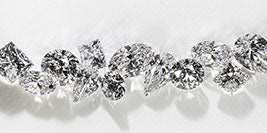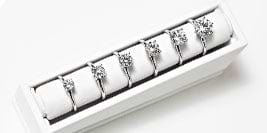Few luxury goods captivate the human imagination and spark desire quite like diamonds. Lab-grown and earth-mined diamonds are scientifically complex, adding to their brilliance and value. They are known for their timeless elegance.
In this article, we will unravel the science behind the sparkle and explain the anatomy of a diamond. We will discuss the scientific intricacies of transforming a rough, uncut stone into a breathtaking gem. We will explain how diamonds are made and the detailed work that enhances their sparkle. Discover the secrets that have made diamonds popular and cherished by jewelry lovers everywhere.
How Diamonds Are Made in the Natural World
First, let’s briefly overview how diamonds are made before exploring diamond anatomy — both in nature and in a lab-controlled environment.
In nature, diamonds are created approximately 90 to 120 miles below the Earth’s surface in the mantle. Under intense heat and pressure, carbon atoms undergo a transformative process known as “high-pressure high-temperature” (HPHT) conditions. These conditions cause the carbon atoms to arrange themselves in a unique crystal lattice structure, forming a rough diamond.
Then, once formed, diamonds remain trapped within the Earth’s mantle until volcanic activity propels them towards the surface. Deep-source volcanic eruptions, called kimberlite eruptions, bring diamonds closer to the Earth’s crust.
Kimberlite is a type of volcanic rock that acts as a conduit for diamonds to reach the surface. As the volcanic magma containing diamonds rises, it cools and solidifies, forming kimberlite pipes. These pipes are the primary source of diamond deposits.
Once diamonds are located, they are extracted through various methods, including open-pit and underground mining. Many worry about the environmental impact of natural diamond mining and the ethical concerns to human communities where mining occurs.
How Lab-Grown Diamonds Are Made
Those ecological and ethical concerns surrounding the practices of diamond mining have given rise to the popularity of lab-grown diamonds, which MiaDonna specializes in as our core business.
Lab-grown diamonds are created by replicating the conditions under which natural diamonds form in the Earth’s mantle. These diamonds have the same physical, chemical, and optical properties as natural diamonds but are manufactured in a controlled environment rather than through geological processes. HPHT and Chemical Vapor Deposition (CVD) are the primary methods for creating lab-grown diamonds.
In the HPHT method, a small seed diamond (a tiny piece of natural or lab-grown diamond) is placed in a carbon source, such as graphite. The materials are compressed and heated to extreme temperatures to replicate conditions deep inside the Earth. These conditions reach pressures of 5-6 GigaPascals and temperatures of 1,400-1,600 degrees Celsius. Under these intense conditions, the carbon atoms arrange into a crystal lattice structure, gradually growing the diamond around the seed.
CVD is another popular method for producing lab-grown diamonds. This process introduces a carbon gas mixture into a vacuum chamber. An energy source, such as microwaves or lasers, is then used to break down the gas molecules, releasing carbon atoms. These atoms settle onto a substrate, typically a thin slice of diamond, and gradually build up to form a diamond crystal. CVD generally allows for more control over the growth process.
Lab-grown diamonds are considered more environmentally friendly and ethical than traditional mined diamonds. They have become the diamond of choice among consumers who want to ensure their diamond purchase is conflict-free, kind to humans and animals, sustainable, and ecologically friendly.
Understanding the Anatomy of a Diamond
A diamond’s anatomy is a roadmap to its unique characteristics, encompassing various elements from its shape and cut to its internal and external features. Consider the following parts of diamond anatomy:
-
Cut: The cut of a diamond is arguably the most critical factor influencing its sparkle. Skilled artisans — diamond cutters — meticulously shape the diamond to maximize the rough stone’s ability to reflect and refract light. The cut is not just about the shape (for instance, round, princess, emerald, etc.) but also the proportions and symmetry. Well-cut diamonds showcase a brilliant play of light, while poor cuts can result in dullness and diminished sparkle.
-
Carat Weight: This refers to the diamond’s size and weight. One carat is equivalent to 0.2 grams, and larger diamonds (both natural and lab-grown diamonds) are generally rarer and more valuable. It is important to note that carat weight alone doesn’t determine a diamond’s overall beauty; other factors, such as cut and clarity, significantly influence its visual appeal.
-
Color: Diamonds are offered in a wide range, from colorless to shades of yellow, red, blue, pink, and green. The Gemological Institute of America (GIA) has created a scale to grade diamonds from D (colorless) to Z (light color). Colorless diamonds are typically more valuable, allowing excellent light transmission and reflection.
-
Clarity: Clarity assesses whether external or internal flaws are present. These are known as blemishes and inclusions, respectively. A diamond’s clarity is also scored, ranging from Flawless (under 10x magnification, there are no visible imperfections) to Included (the naked eye can see visible imperfections). The fewer imperfections there are, the higher the clarity grade.
-
Fluorescence: Some diamonds exhibit fluorescence when exposed to ultraviolet (UV) light. This phenomenon can affect a diamond’s appearance in certain lighting conditions. Diamonds may fluoresce in colors like blue or yellow (blue being the most common), and their impact on perceived beauty varies from stone to stone.
-
Symmetry and Polish: Symmetry refers to the precision of a diamond’s shape and alignment of its facets, while polish assesses the smoothness of its surface. Both factors contribute to the overall aesthetic quality of the diamond and its ability to reflect light effectively.
-
Table and Depth: The table is the flat, top facet of the stone, while depth refers to its overall height. The proportions between these two elements affect the diamond’s brilliance. Well-balanced proportions ensure optimal light reflection and refraction, creating a more visually appealing and beautiful stone.
The lab-grown diamond experts at MiaDonna believe that understanding the anatomy of a diamond empowers buyers to make informed choices based on personal preferences and budget considerations. No matter if you seek the fiery brilliance of a round cut diamond, such as that which is showcased in our Tracie Solitaire Engagement Ring, or the sleek elegance of an emerald cut stone, like in our Zara Engagement Ring, appreciating the nuances of a diamond’s anatomy adds depth to the fantastic world of these precious gems.
The Main Components of Diamond Ring Anatomy
Next, examine the various parts of the anatomy of a diamond. Each of these components contributes to its overall appearance and beauty.
Here are the main parts of a diamond and the terminology you need to know regarding a diamond’s features:
-
Table: The table is the flat, top facet of the diamond. It is the most significant facet and is critical to how light interacts with the diamond. Well-proportioned tables contribute to the diamond’s brilliance.
-
Crown: The crown is the upper portion of the diamond, extending from the table to the girdle. It includes a series of facets, with the uppermost being the table. The crown’s facets help reflect and refract light, enhancing the stone’s sparkle.
-
Girdle: The girdle is the outer edge or rim of the diamond, where the crown and pavilion meet. It acts as a protective boundary and can vary in thickness. The girdle may be faceted, polished, or unpolished.
-
Pavilion: The pavilion is the lower portion of the diamond, extending from the girdle to the culet. Like the crown, the pavilion consists of facets that reflect and refract light within the diamond.
-
Culet: The culet is the tiny facet or point at the bottom of the stone. Its presence or absence can affect the appearance of the diamond. In well-cut diamonds, the culet is usually very small or nonexistent.
-
Facets: Facets are flat, polished surfaces on the diamond that interact with light to create brilliance and fire. Diamonds can have numerous facets, each playing a role in dispersing the play of light within the stone.
-
Crown Angle: The bezel facets and the table form the crown angle. It influences how light enters and exits the diamond, affecting its brilliance.
-
Pavilion Angle: The facets and the girdle form the pavilion angle. Like the crown angle, this plays a part in how the diamond reflects and refracts light.
Anatomy of a Diamond: Other FAQs
Common Questions About Diamond Anatomy
What are fancy-shaped diamonds, and how do they differ from round diamonds in terms of diamond anatomy?
Fancy-shaped diamonds include various shapes such as princess, emerald, marquise, and pear. Understanding the anatomy of these shapes involves exploring unique facets, proportions, and considerations specific to each shape. Some examples of fancy-cut diamonds from MiaDonna include the Katherine Accented Engagement Ring shown with a pear cut center stone, and the Charm Engagement Ring shown with an emerald cut center stone.
How do different diamond cuts, such as ideal and excellent, influence the diamond’s brilliance and overall aesthetic?
Exploring the distinctions between different cut grades and their impact on light performance empowers a diamond shopper to decide based on the desired level of sparkle and brilliance.
Are there specific considerations for diamond anatomy when choosing an engagement ring?
Exploring topics related to selecting a diamond for an engagement ring, such as popular shapes, settings, and how to prioritize different factors within a budget, provides practical insights for lab-grown diamond engagement ring shoppers.
What is the significance of diamond proportions on the diamond’s anatomy, and how do they impact the stone’s overall beauty?
Proportions, including table size, crown height, and pavilion depth, are crucial in how a diamond interacts with light. Well-balanced proportions contribute to a diamond’s brilliance and fire.
How do diamond certifications like those from the GIA contribute to understanding a diamond’s anatomy and quality?
Certification from reputable gemological laboratories provides a detailed analysis of a diamond’s characteristics. Understanding the formation of a diamond certificate plays a crucial role in making an informed purchasing decision.
Consult with our experts with any additional questions about diamond anatomy.
MiaDonna is passionate about providing our loyal patrons with the highest quality lab-grown lab-grown diamonds. As such, we are also committed to ensuring the shoppers who trust us are armed with the knowledge and education they need to make a lab-grown diamond purchase that will be treasured forever.
We invite you to reach out to us regarding any additional questions you may have about diamond anatomy and how certain factors can influence the way a stone appears in a jewelry setting. We host in-person appointments at our Portland store and virtual appointments anywhere in the world!
Schedule a one-on-one consultation today, and let’s begin the process of finding the diamond you have been dreaming about.





























